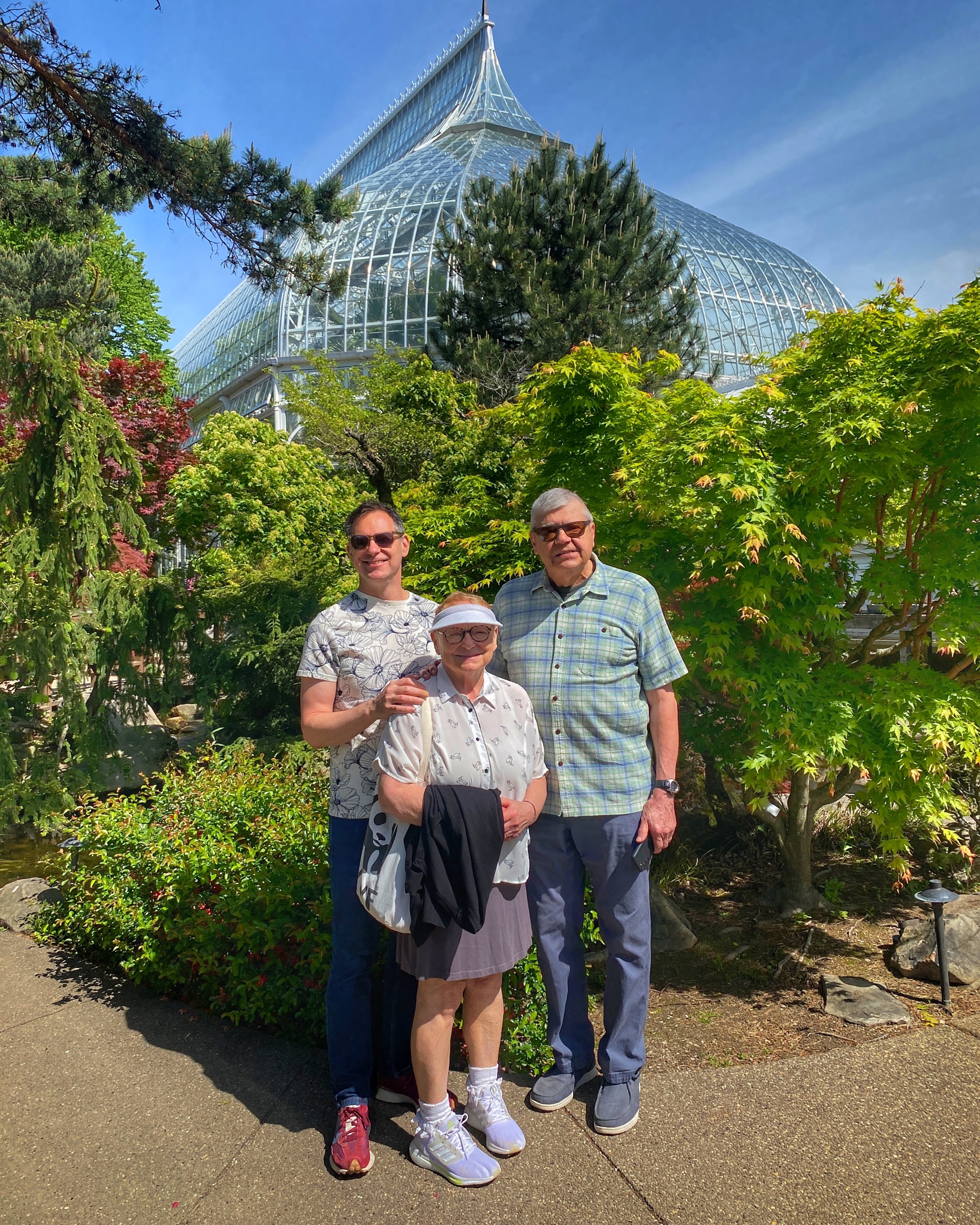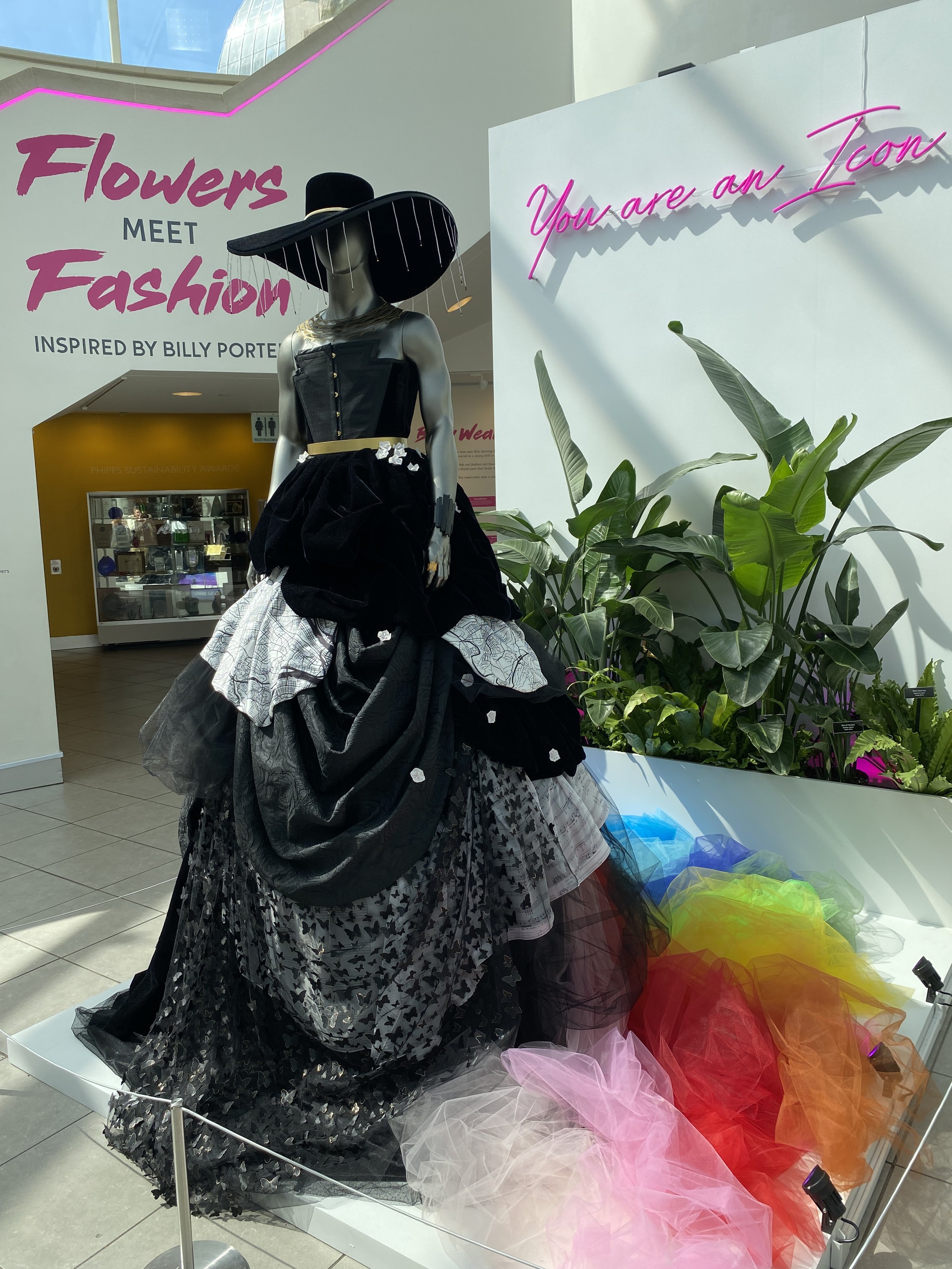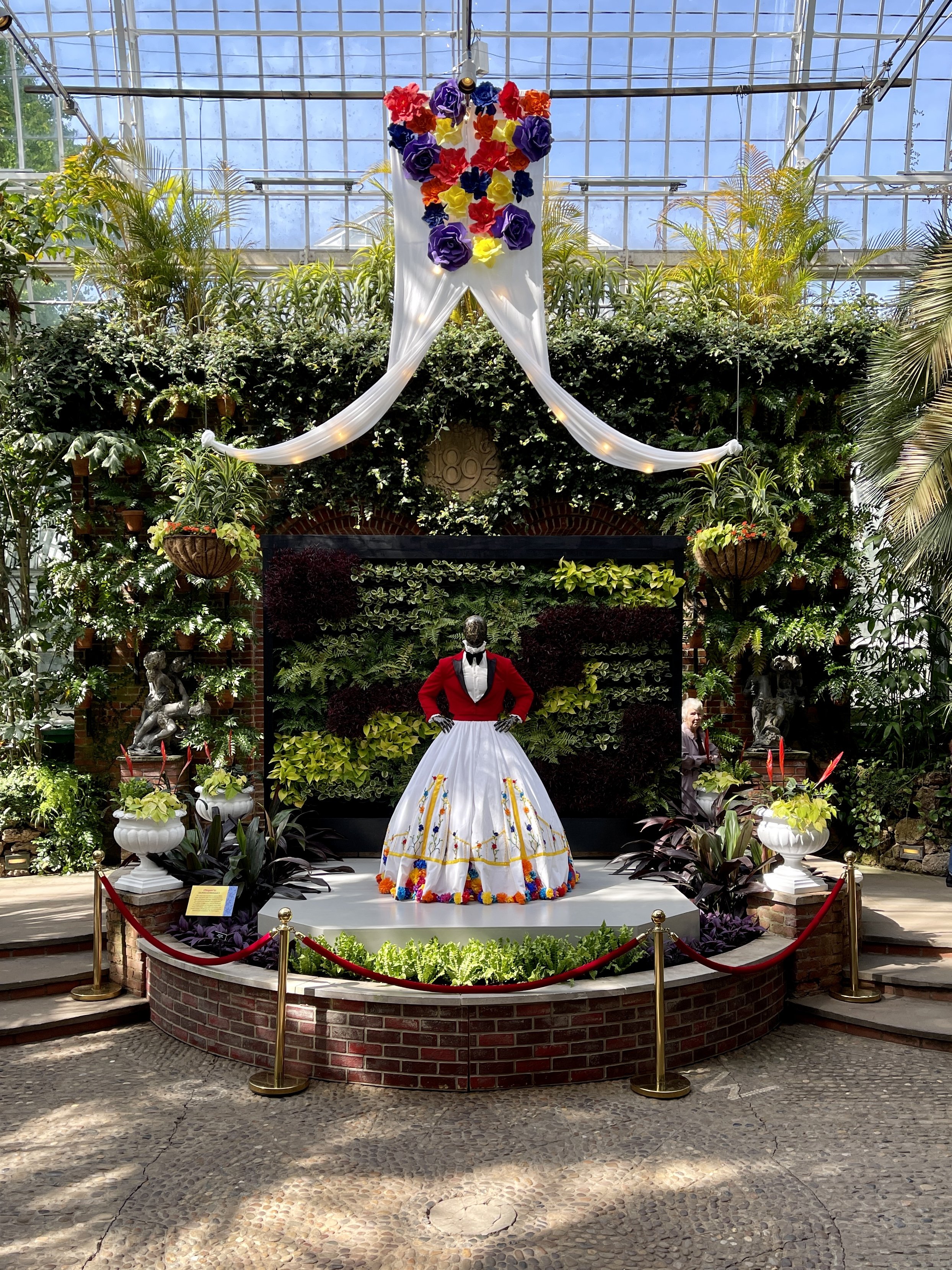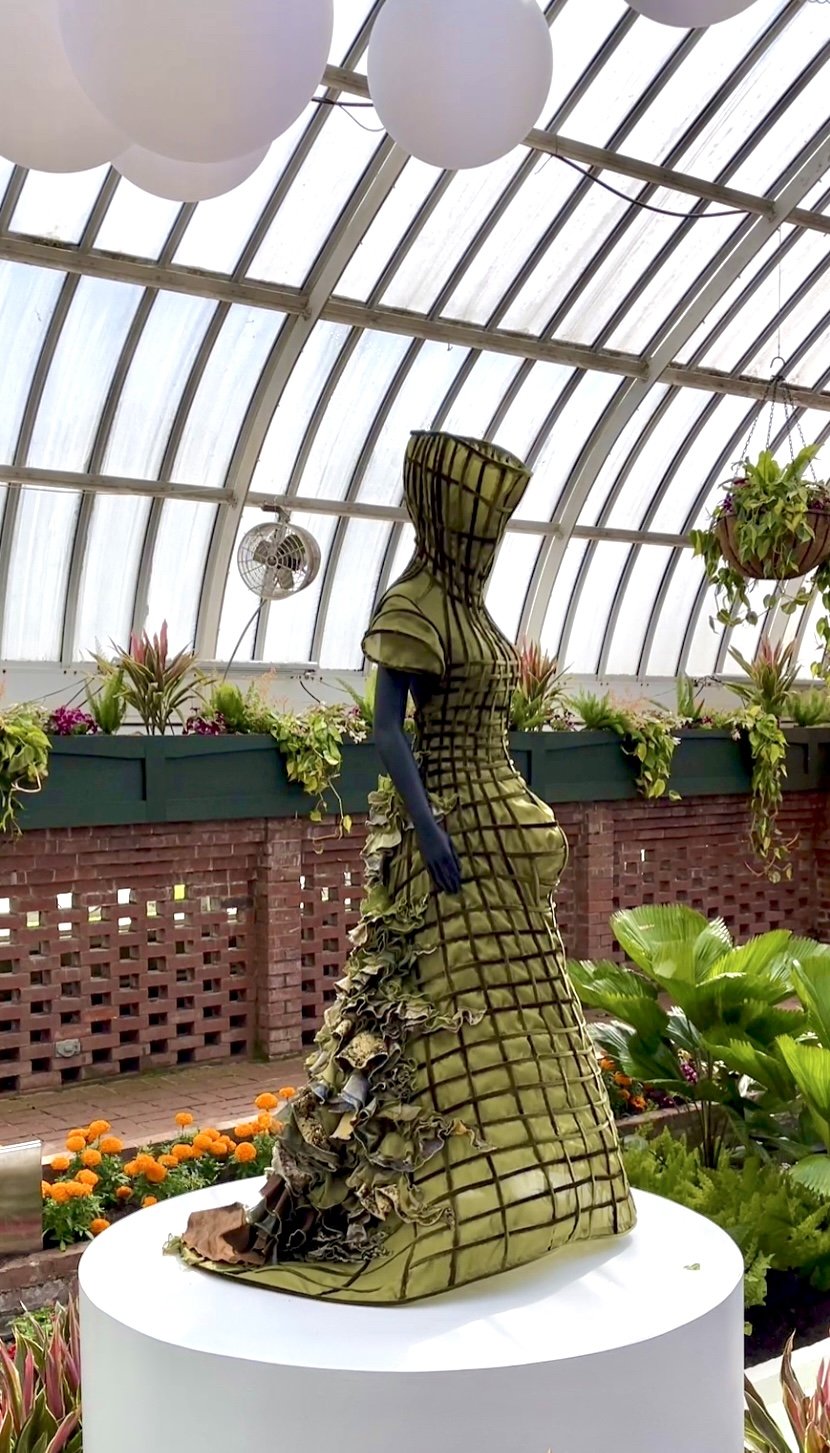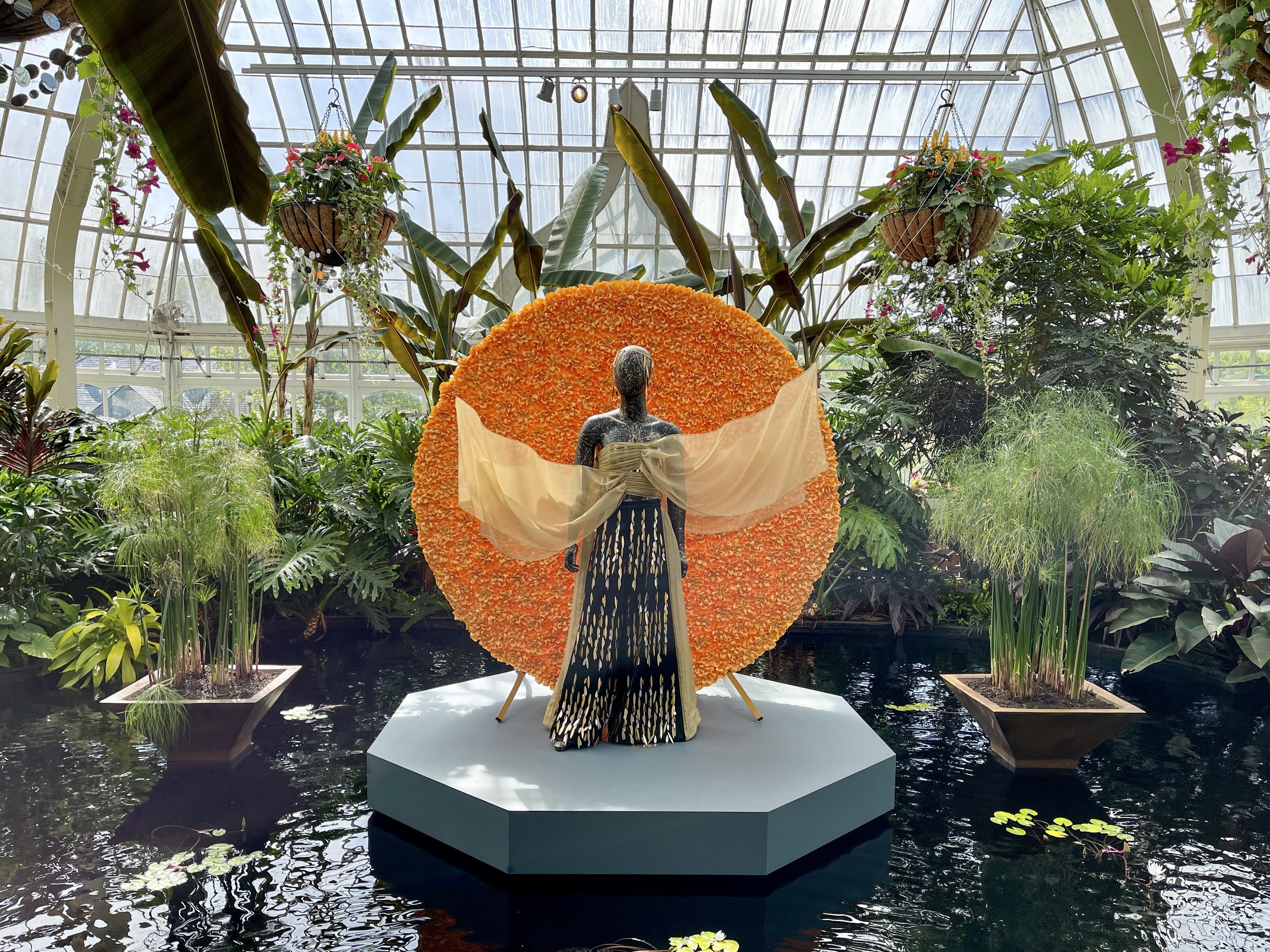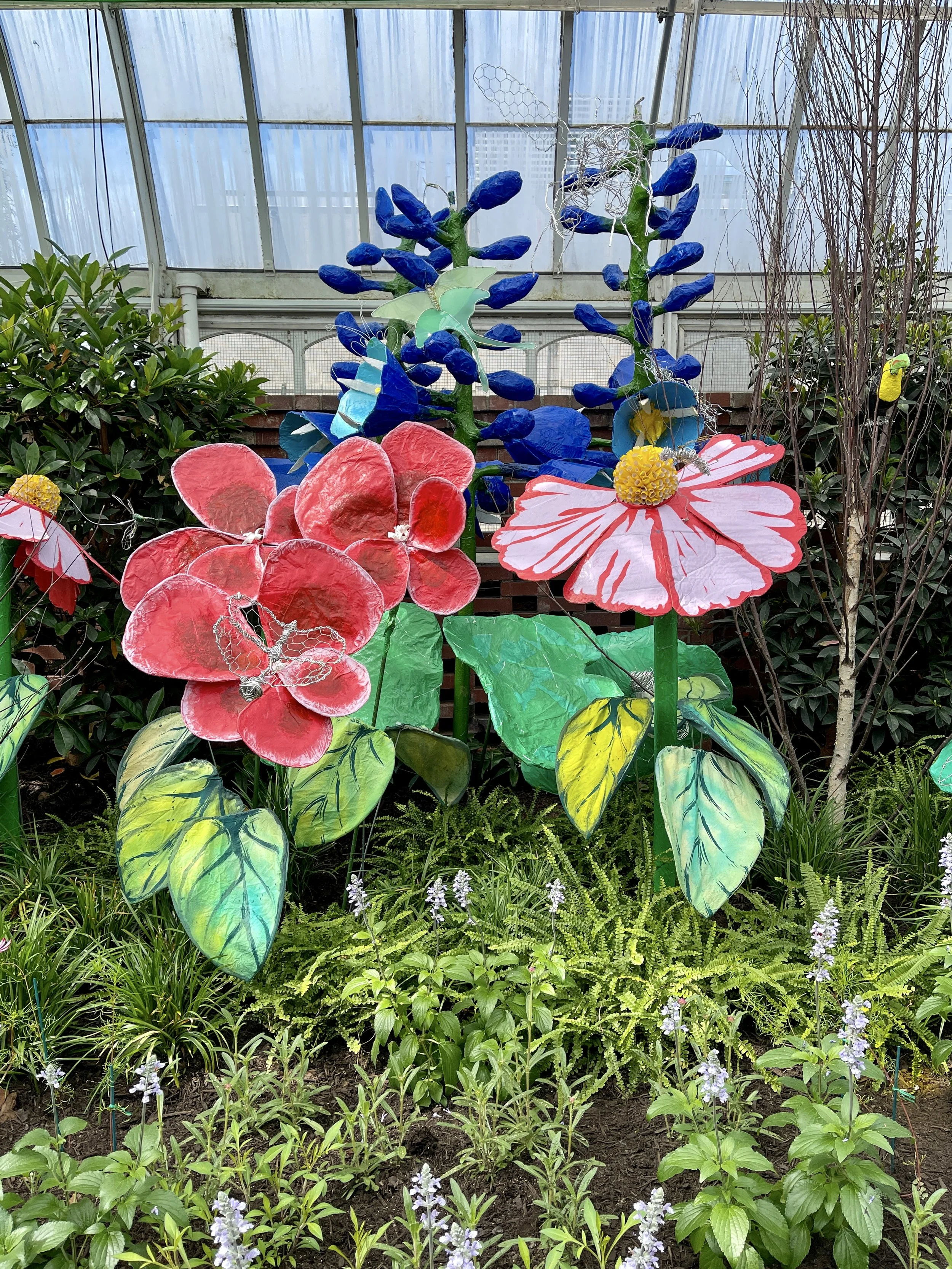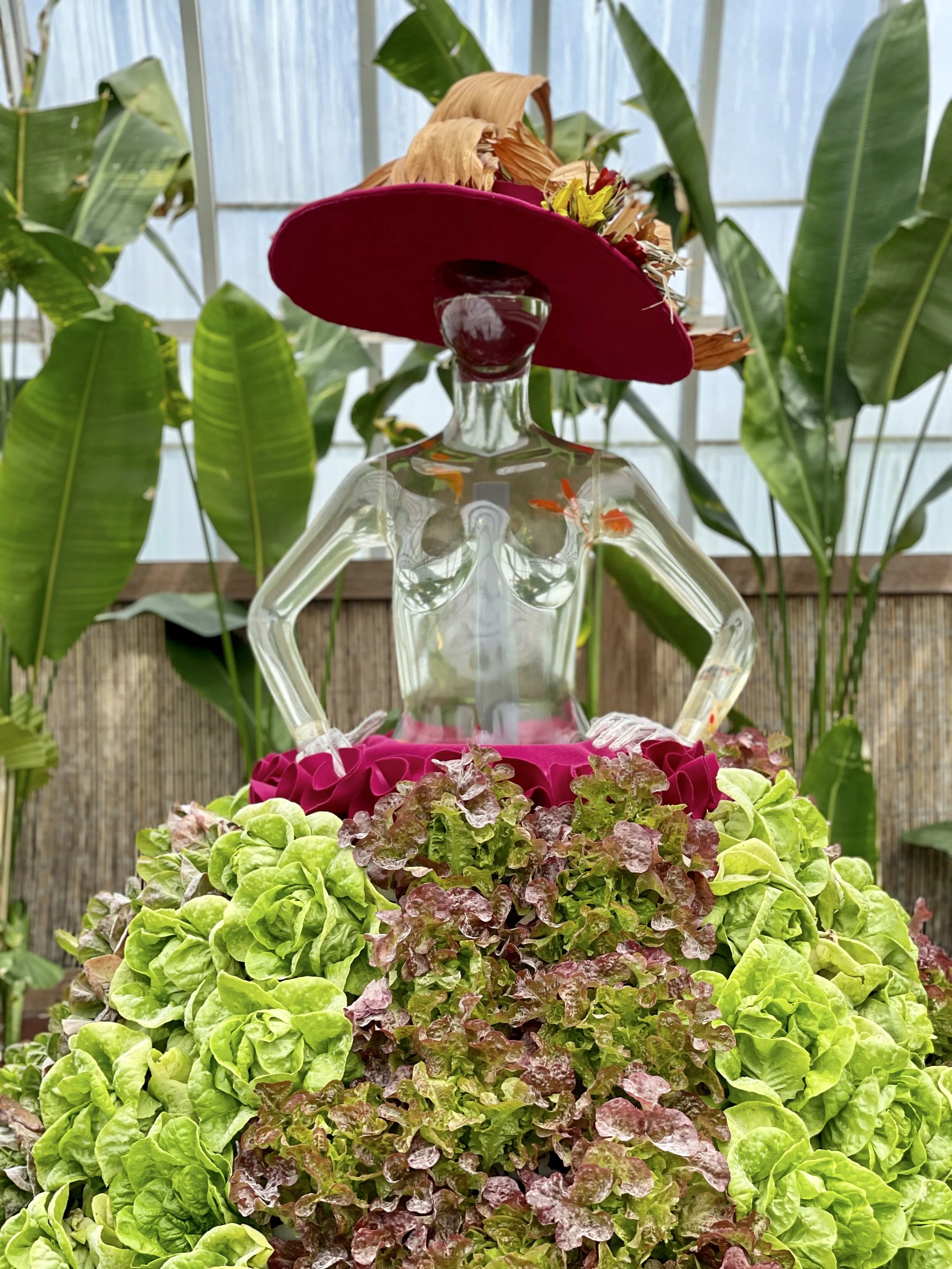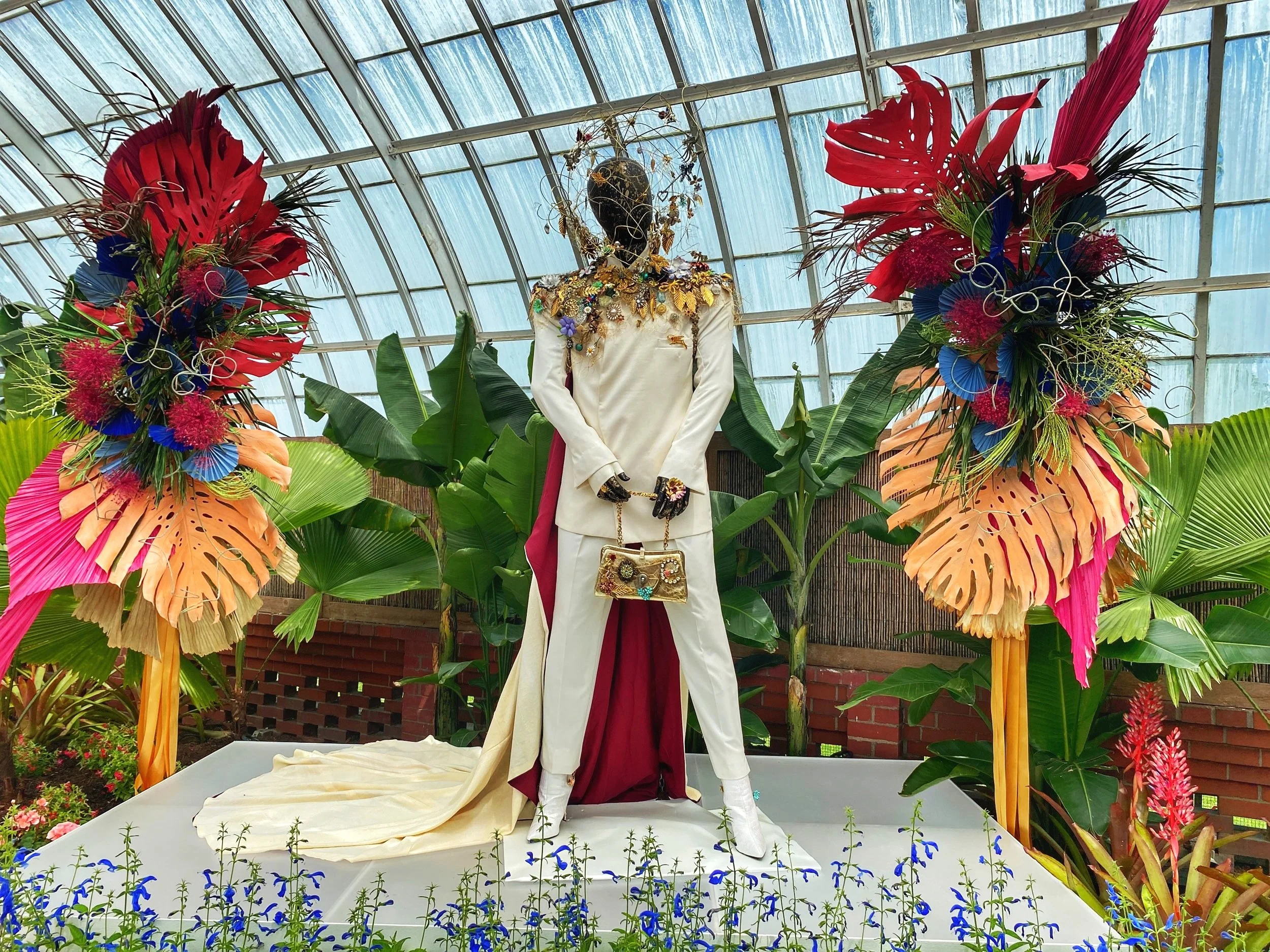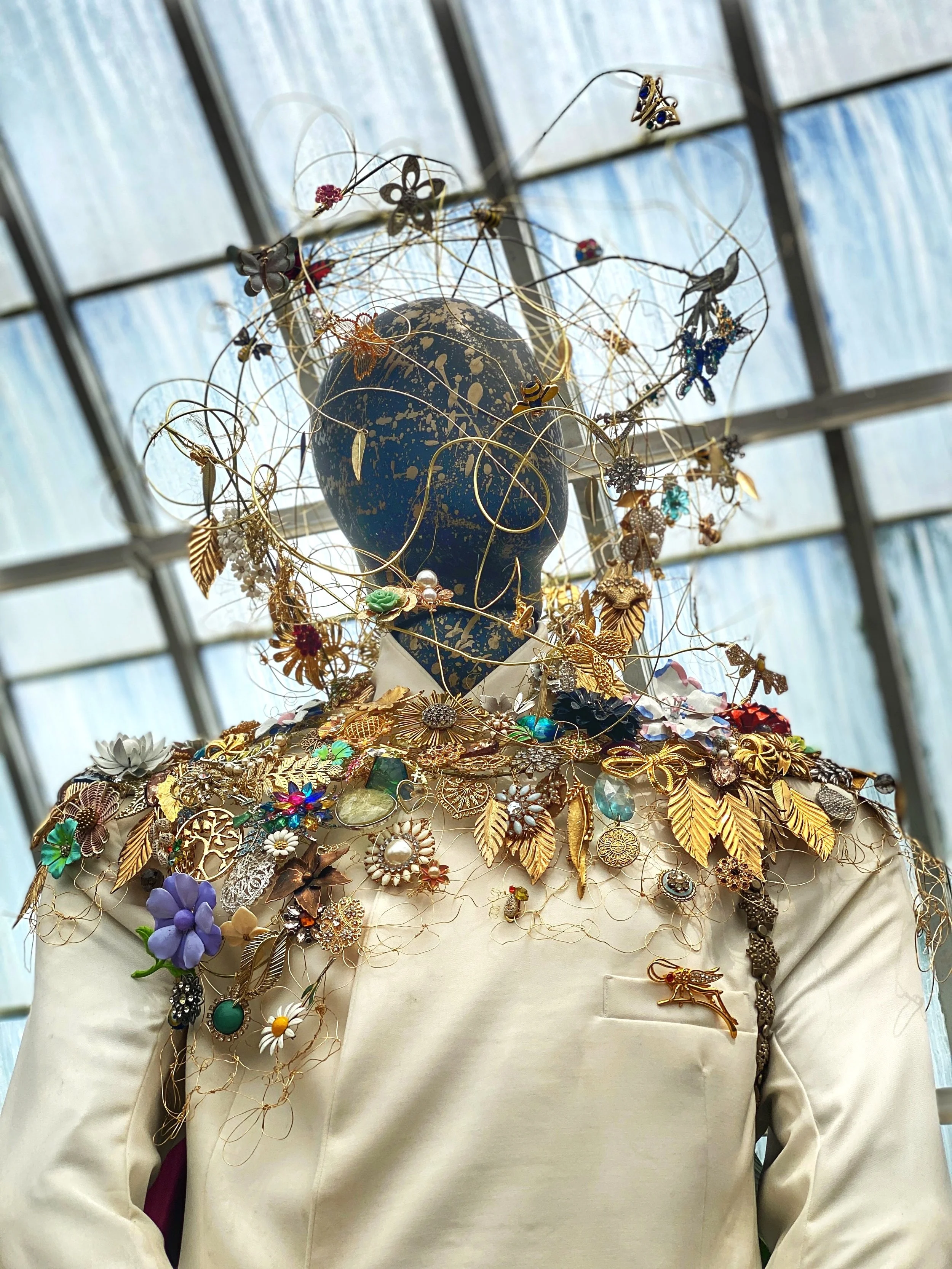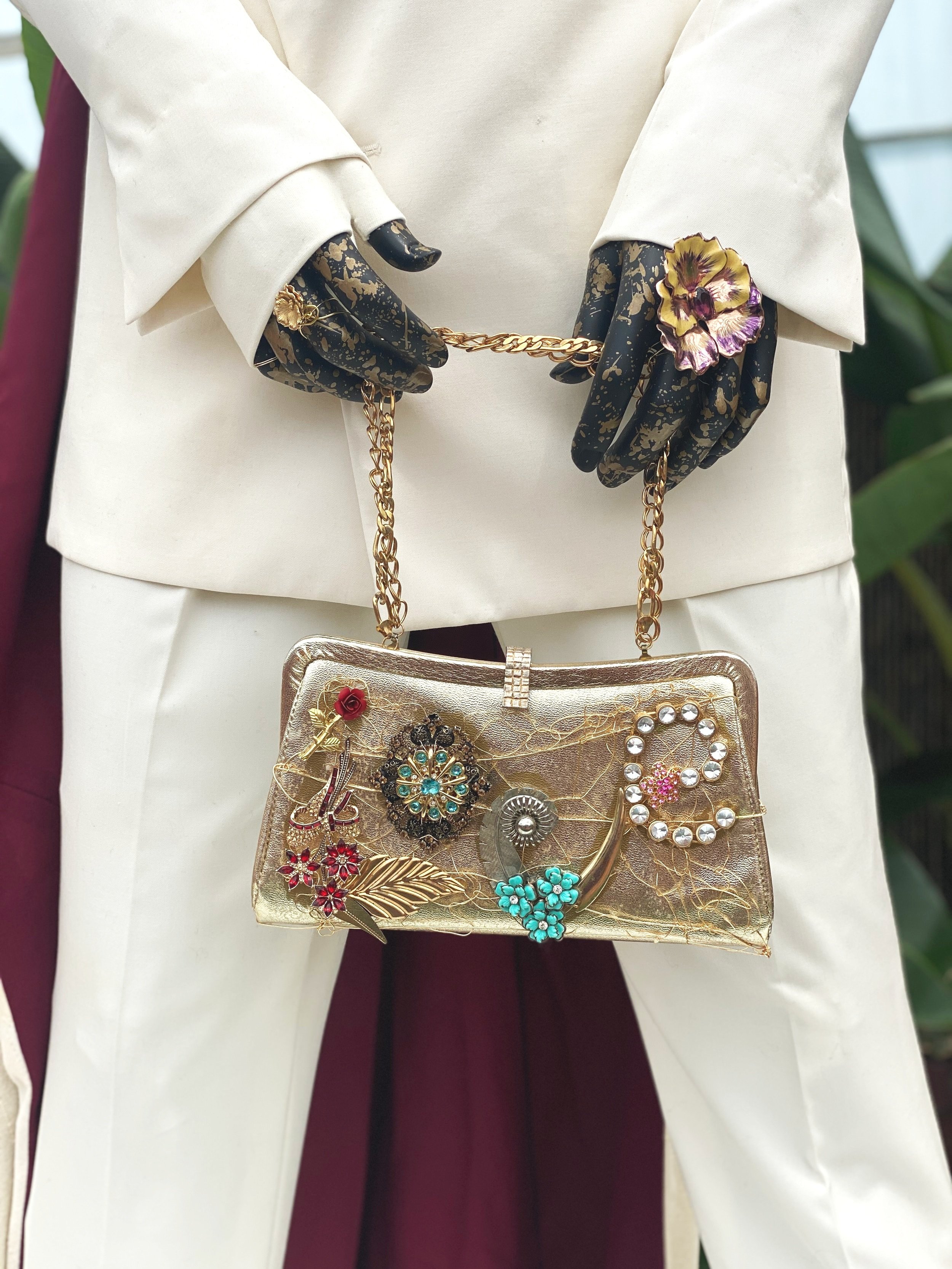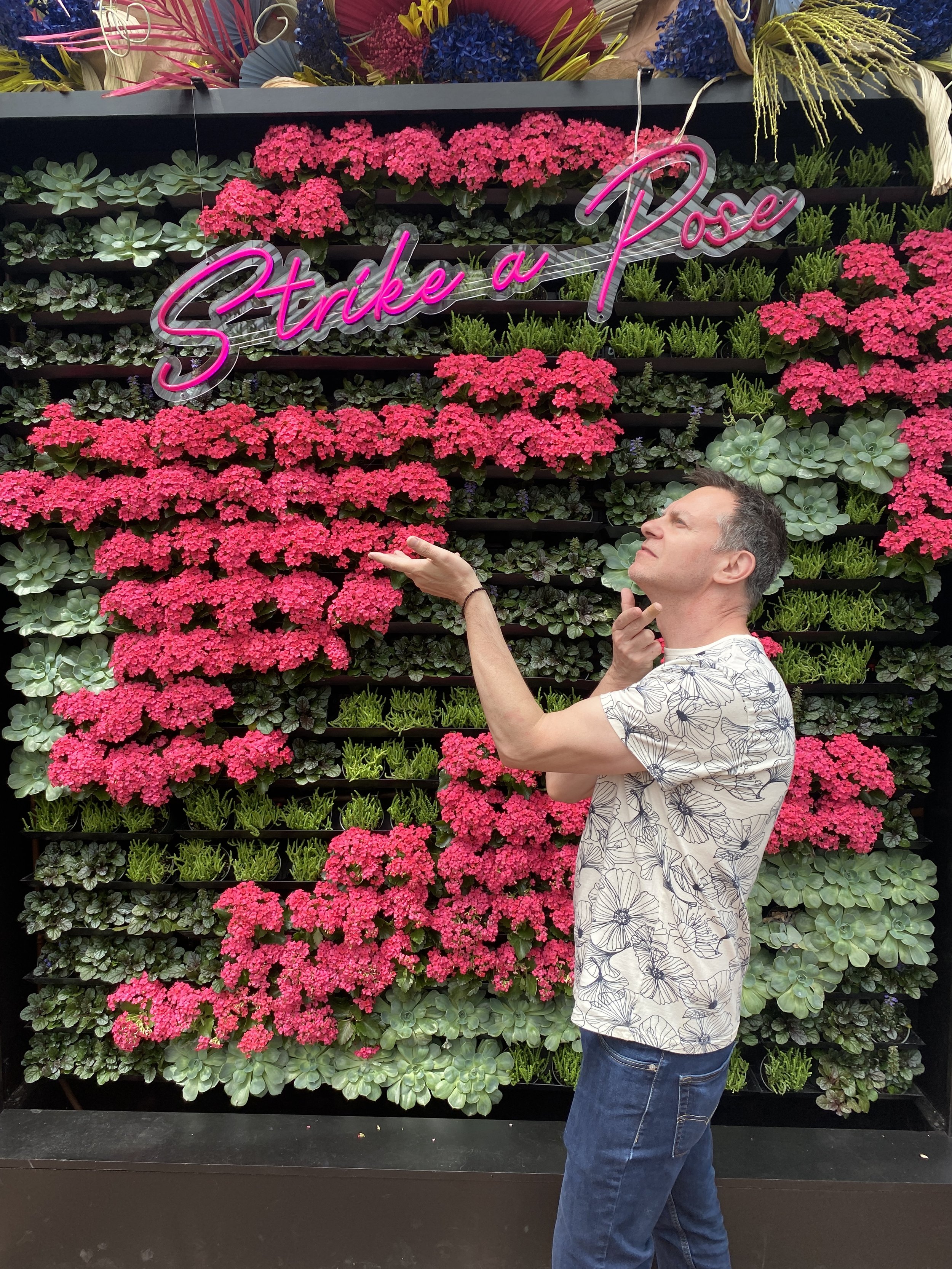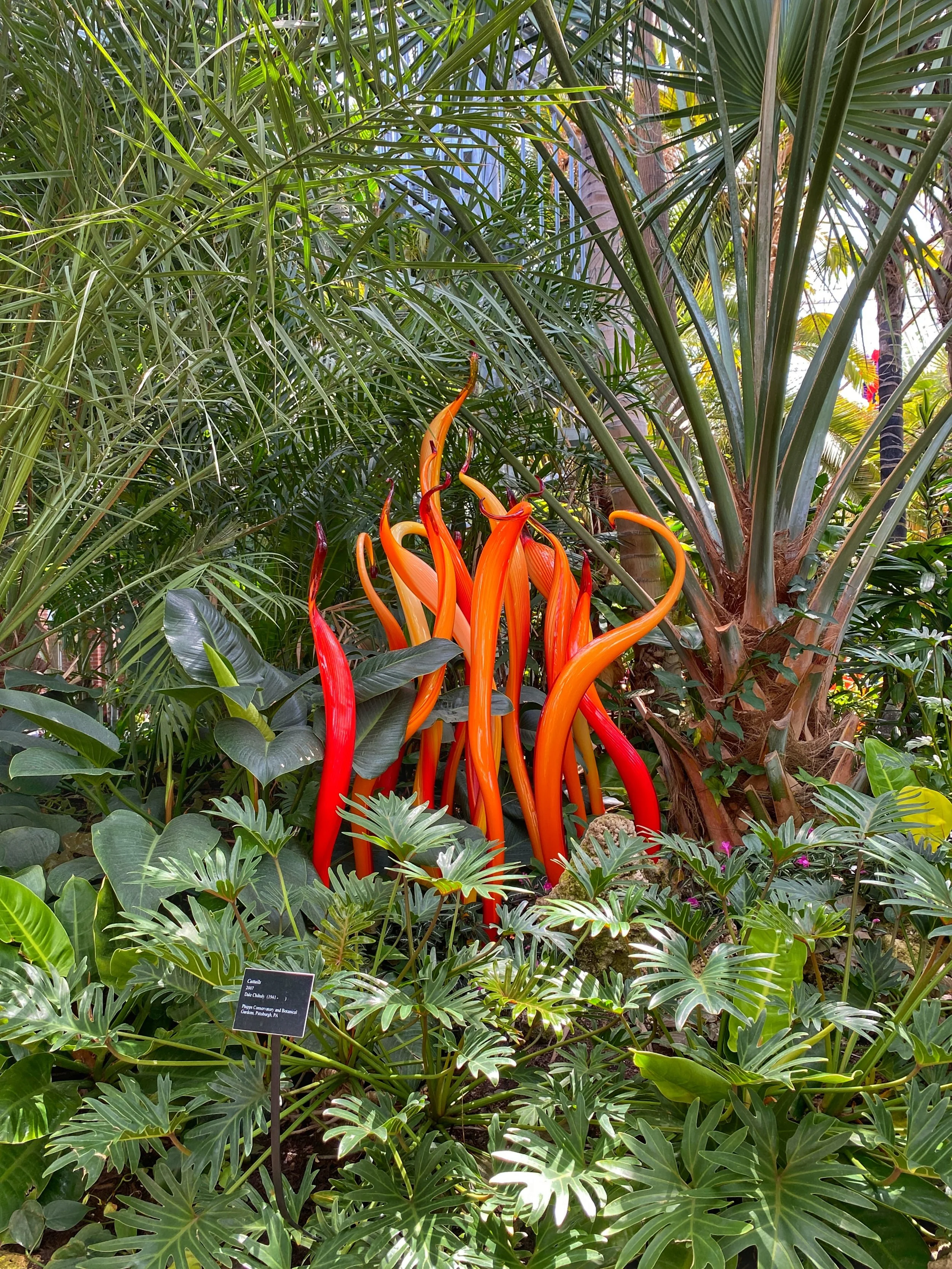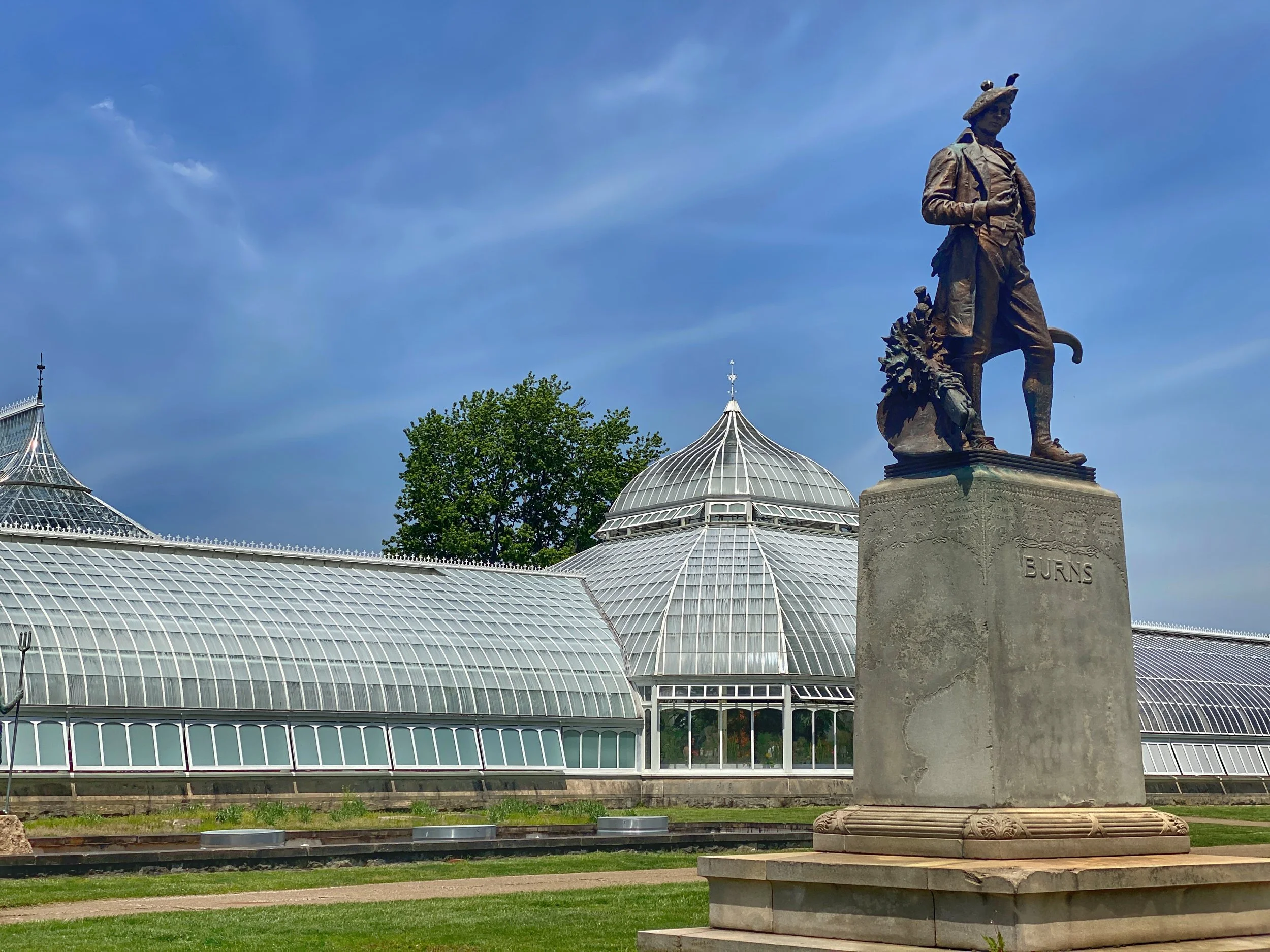A journey through the impressive Phipps Conservatory and Botanical Gardens in Pittsburgh, where the latest exhibit, Flowers Meet Fashion: Inspired by Billy Porter is a fusion of flora and fabulousness. Strike a pose!
Duke, Mima and Papa were so inspired by the Japanese Garden at the Phipps Conservatory and Botanical Gardens, they decided to only speak in haiku.
I’ll say it: The Phipps Conservatory and Botanical Gardens puts Chicago’s Garfield Park Conservatory to shame. It was definitely one of the highlights of our trip to Pittsburgh, Pennsylvania, where we spent a delightful long weekend with my parents. This stunning gem of Victorian-era architecture, adjacent to Panther Hollow in Schenley Park, has captivated guests for more than a century — and is sure to do so for years to come.
Visitors to the Phipps are greeted by a towering figure standing in front of a pink neon sign that reads, "You are an Icon." The skirt is made of petal-like layers. If you look closely, you can see hidden details, such as a map of Pittsburgh and song lyrics from the musical Kinky Boots.
From Roots to the Runway
Throughout the year, the conservatory changes themes seasonally, and our visit serendipitously coincided with the opening day of their summer show, Flowers Meet Fashion, a celebration of native son Billy Porter's local roots, his sartorial style and his love of flowers.
For those of you who don’t know, Porter is an Emmy, Grammy, and Tony award winning performer and fashion icon. Billy is well known for his bold, creative and androgynous style, and is a tireless advocate for LGBTQ+ rights. According to the Pittsburgh Post-Gazette, the seeds for the show were sown in the summer of 2021, when Porter returned to the City of Champions to direct the movie Anything's Possible, a coming of age romantic comedy about a trans girl in her senior year of high school. While shooting scenes at the conservatory, Billy found common ground with the personnel and decided to become a board member.
As Billy wrote in his memoir, Unprotected:
I didn’t have the words for any of this at the time, just a child's awareness that people carried themselves differently in different clothing, that fashion could affect a profound transformation, on the outside and inside both.
The Phipps purchased a few favorites from past exhibitions to add to their permanent collection, including American glass sculptor Dale Chihuly’s Goldenrod, Teal and Citron chandelier. The stunning sculpture hangs in the atrium, where it can be enjoyed by all visitors.
A Welcoming Homage to Porter’s Pittsburgh Roots
Our experience began on the ground floor of the airy glass-domed Welcome Center, where a 7.5-foot-tall silver mannequin positioned near the entrance stood wearing a voluminous black gown. Entitled “Home Grown: Planted Roots,” the garment was designed by Madison Michalko, one of six professional costume designers tapped to create pieces for the show.
Michalko found her muse in Billy’s gender-fluid style and in the state of Pennsylvania. The bodice of the dress is shaped like a keystone, the state’s official symbol, accented with gold buttons and white mountain laurel blossoms, the state flower. The wide-brimmed hat is a nod to the crystal-fringed one Porter wore at the 2019 Grammys and features strands of LED lights that flicker like lightning bugs, the state insect.
This tuxedo dress by Damian Dominguez is a powerful statement about the importance of self-expression and the freedom to be who you are. The top is an homage to Mister Rogers, while the skirt is a nod to Dominguez’s Mexican heritage.
Palm Court: The Dress That Defied Convention
The four of us took an elevator up to the first of 14 interconnected conservatory pavilions and entered the spectacular Palm Court. The palms grow in the central and largest room of the conservatory, which reaches 65 feet in height, is 60 feet wide and 450 feet long.
Holding court before us on a raised platform was a stunning dress by Mexican-American costume designer and Carnegie Mellon University alumnus Damian E. Dominguez. The look was inspired by the now-iconic black velvet tuxedo gown and matching bolero jacket designed by Christian Siriano for Porter to wear at the 2019 Academy Awards. Porter’s ensemble pushed boundaries and raised a few eyebrows at the somewhat restrained awards show.
Like Siriano’s dress, Dominguez’s gown is also made from velvet but features a red tuxedo jacket in a nod to another Pittsburgh native, Fred Rogers. The hand-embroidered skirt includes a yellow bridge, as well as marigolds and dahlias, a nod to the designer’s heritage and the traditional full skirts of Mexico, where Dominguez’s parents were born.
Carnegie Mellon students Chloe Brown, Huixin Kang, and Jen Tepe reimagined a 1960s pantsuit that takes inspiration from the late British fashion designer Alexander McQueen's iconic Sarabande dress.
Sunken Garden: A Beacon of Hope
Our next stop was the Sunken Garden, which was filled with the colorful and creative designs by students from the Fundamentals of Costume Design class taught by Susan Tsu, professor of design at Carnegie Mellon, Porter’s alma mater. The students had been asked to read his memoir and then work in teams to create designs that reflected different aspects of Porter’s life and career.
We paused to admire the sheer white pantsuit with crocheted fungi created by Chloe Brown, Huixin Kang and Jem Tepe. The designers explained that the fungi are a botanical metaphor for Porter’s exploration of his identity and his journey to self-reliance.
Could there be a pea in this pod? Caifeng Hong and Katherine Chung’s design was out of this world.
Caifeng Hong and Katherine Chung’s look was inspired by the theme of contrast and rebirth. The dress is made of olive green netting layered over a green silk organza gown and collar that conceals the face of the mannequin. The contrast between the light and airy netting and the heavy and luxurious organza creates a sense of movement and energy. The collar, meanwhile, adds a touch of mystery and intrigue. The overall effect is a dress that is both ethereal and otherworldly, evoking something extraterrestrial.
Carrie Anne Huneycutt and Evan Riley’s collaboration was Somewhere Over the Rainbow, celebrating Porter's legacy as a trailblazing figure in the LGBTQ+ community.
Carrie Anne Huneycutt and Evan Riley collaborated on the third look, entitled “Statue of Liberation.” The corseted dress is enveloped by a shimmering rainbow that soars above the mannequin’s head and is held aloft by a torch made of colorful fabric strips. The “flames” emanating from the torch represent Porter’s passion, determination and generosity of spirit.
Cathy Trostle-Olivar's dazzling Egyptianate look floats above the water of the Victoria Room.
Fit for a Queen: From Camp to High Art
In the Victoria Room, a luminous costume rose from the waters. The look was designed by Cathy Trostle-Olivar and was inspired by Porter’s glittering gold Egyptian sun god Ra costume at the 2019 Met Gala. The theme that year was camp, which Porter said can sometimes be seen as “cheesy.” However, when executed properly, it can ascend to “the highest forms of fashion and art.” The pavilion uses blue Egyptian lotus aka waterlily and tall stately papyrus to great effect.
Three bronze maiden statues by Edmond Amateis, which originally stood within niches in the walled garden of the local Mellon estate, hold court among the formal French garden at the back of the Broderie Room.
The Broderie Room: The XIV Factor
Modeled after the formal period gardens of French chateaux during the reign of Louis XIV, the Broderie Room takes its name from the French “parterre de broderie,” a type of garden arrangement translated as “embroidery of earth.” This style of garden design came from a time when nature was considered a force to be tamed.
I don’t speak French, but I think that this photo of Wally and Mima is très mignon.
This fabulous footwear is a wink to the 2013 musical Kinky Boots, which Porter starred in, and a reminder that sometimes the most unexpected things can save the day.
While visitors are discouraged from throwing coins into the many ponds and water features throughout the conservatory to protect the flora and fauna, a wishing well can be found here.
Chihuly’s celestial Desert Gold Star sculpture provides a brilliant blast of color amid the green hues of desert flora.
These flowers are so whimsical, they could have been plucked straight out of a Dr. Seuss book.
Gallery Room: Blooming With Creativity
Visual arts students from CAPA 6-12, a local creative and performing arts school, have transformed the Gallery Room at Phipps Conservatory into a whimsical wonderland. Using papier-mâché, the students have created larger-than-life flowers and animals that are sure to delight visitors of all ages.
The Gallery Room showcases a collection of critters created by local students.
The centerpiece of the exhibit is a towering salvia spike that nearly reaches the ceiling. The spike is made up of hundreds of individual flowers, all of which have been carefully hand-crafted by the students. And in the center of the room, a menagerie of amphibians and animals frolic in a whimsical forest.
These looks made from plant material by Phipps master gardeners were so avant-garde, they could be on the red carpet at the Oscars.
South Conservatory: “Hort” couture
The sound of camera shutters and the strobe of flashbulbs add a fun theatrical element to the red carpet vibe of the South Conservatory room. Wally spoke with one of the friendly conservatory staffers, who informed him that the topiary models were created by the master gardeners at the Phipps. The nature-inspired garments were fashioned from plant material sourced and crafted onsite at the conservatory and are so stunning, they would impress the judges on Project Runway.
The first mannequin featured a dried leaf hat in the shape of a lady slipper orchid, and a full skirt fabricated from clusters of blue hydrangea flowers contrasted by a form-fitting acid green palm frond bodice.
This look, inspired by a tetra fish, is sure to turn heads — even underwater!
The second look reimagines the scales of a neon tetra fish. Blue-painted magnolia leaves create a fish scale pattern on the jacket and hood, while salal leaves were used for the pants. Marigold-colored staghorn ferns are transformed into the cuffs and lapels, and painted monstera leaves create the “tail fin.” The deep-sea diver-like boots are made of upcycled accession tags, the metal labels that are issued to plants when they become part of the Phipps collection.
Well, this look is one fashion-forward way to channel your inner bird (note the nest atop its head and the dress details made of pheasant feathers).
The third look uses salal leaves trimmed with pampas grass and a dried grapevine garland to create drama and height, encircling the mannequin's waist and head like a bird’s nest. Completing the look are upcycled accession tag bracelets and white pheasant tail feathers.
The woman Wally had spoken with about the topiary models also told him about the Tropical Forest Conservatory, a 12,000-square-foot, 60-foot-high space located behind the South Conservatory. If she hadn't, I think we might have walked right by it, which would have been a shame. The incredible space is home to the immersive Tropical Forest Hawai'i, showcasing a variety of endemic and native species from the state.
As soon as we stepped inside, we were transported to another world. The air was humid and warm, and we were surrounded by lush vegetation, with towering native trees and cascading waterfalls.
This lettuce-covered look was a showstopper. I sure hope there’s an opening under the hat so the fish can eat!
The Serpentine Room: Salad Days and a Surprise
As we made our way past the final five costumes, found in the Serpentine Room, I was unsure which look I liked best. But once I saw the aquaponics dress, I knew without a doubt that it was my favorite. The ingenious installation was a truly innovative and sustainable design. The clear acrylic body contained live goldfish, and the hoop skirt was made of living lettuce. A placard explained that the lettuce cleans the water and maintains a healthy ecosystem for the fish, whose waste, in turn, fertilize the plants. It was a truly beautiful — and functional — piece of art.
Drag queen Thee Suburbia’s ruby red dress is a tribute to Porter’s uplifting message and blooms with the power of positivity.
Brooklyn-based drag performer Thee Suburbia designed the ruby red dress. She was inspired by a personal encounter with Porter, who spoke to the entire crew about the importance of lifting one’s surroundings, while working on a music video shoot for his song “Children.” Thee Suburbia’s gown pays homage to Porter’s attire that day as well as his words. The bursting blooms are a metaphor for the power needed to be an uplifting and inspiring force. It’s a friendly reminder to Phipps visitors that we can make the world a better place by lifting each other up.
Mindy Eshelman’s sustainable suit and cape is a sartorial love letter to Pittsburgh and our planet.
Next up was a white mandarin collar suit and oxblood-lined cape designed by Mindy Eshelman, associate professor of costume design at Carnegie Mellon. The sustainable, locally sourced and upcycled vintage piece was a perfect reflection of Porter’s deep connection to Pittsburgh, as well as the possibilities for our collective future — one in which caring for the planet is imperative. The look has been paired with vintage brooches, including flowers for Phipps, bees recalling our interconnectedness with the natural world, and butterflies symbolizing personal transformation.
NYC performer Gloria Swansong’s designs evolved from the long-established pageantry of drag queen balls, a parade of gender expression and aesthetics.
To close out the show, New York City drag performer Gloria Swansong served up two stunning looks inspired by the underground 1980s ballroom scene. Category is: Botanicals Eleganza.
The first was an Old Hollywood-style gown made of shimmering blush pink silk organza. The sleek form-fitting dress was adorned with silk roses handmade in NYC by M&S Schmalberg.
The second look was an iridescent bouquet sleeve dress, a beautiful and meaningful tribute inscribed with the names of ballroom legends to honor their contributions to the community.
Don't forget to stop and “Strike a Pose” in front of the Instagram-friendly pink and green vertical wall before you leave the Serpentine Room.
Café Phipps: Lunch Break
We arrived at the conservatory at 10:30 a.m. and were starving by noon. My dad and I are both notorious for getting hangry, so the four of us headed over to Café Phipps, which is located in the Welcome Center, across from the gift shop.
After taking a look at the elevated and healthy menu options, we agreed to have lunch there. The menu featured a variety of dishes made with fresh, seasonal ingredients. Wally and I shared a spinach and kiwi salad and a Hawaiian pulled pork sandwich. Both were delicious and satisfying.
Another Chihuly work, Celadon and Royal Purple Gilded Fiori, captures attention at the center of the Tropical Fruit and Spice Room.
Chihuly’s vibrant glass installation, Cattails, can be found nestled amongst the lush greenery of the Palm Court.
The Porter-inspired show is a delightful experience, where talent and collaboration flourish. Whether or not you make this summer’s show, though, the Phipps is a feast for the senses.
Be sure to find the Longfellows by Hans Godo Fräbel in the Orchid Room.
The Lowdown
Flowers Meet Fashion: Inspired by Billy Porter is on display at the Phipps Conservatory and Botanical Gardens until June 25.
Admission is $21.95 for adults; $19.95 for students over 18 and seniors 62 and older; $13.95 for children ages 2-18; and free for Phipps members and children under 2.
A bronze sculpture of Scottish poet Robert Burns, holding a plow and contemplating a mountain daisy, stands outside one of the Victorian glasshouses at the Phipps Conservatory.
Phipps Conservatory and Botanical Gardens
1 Schenley Park Drive
Pittsburgh, Pennsylvania
USA

